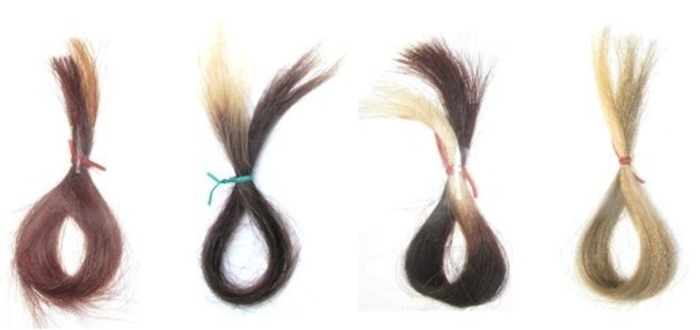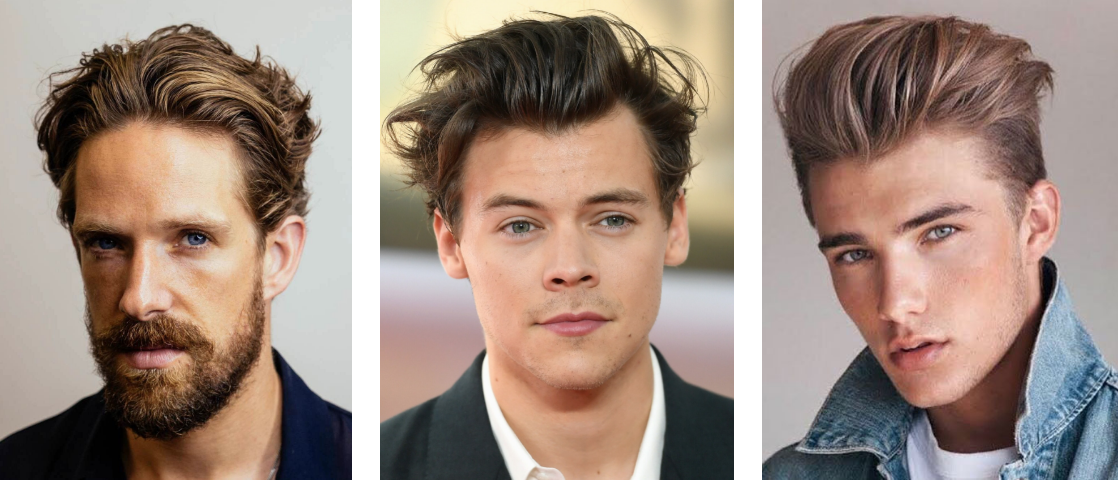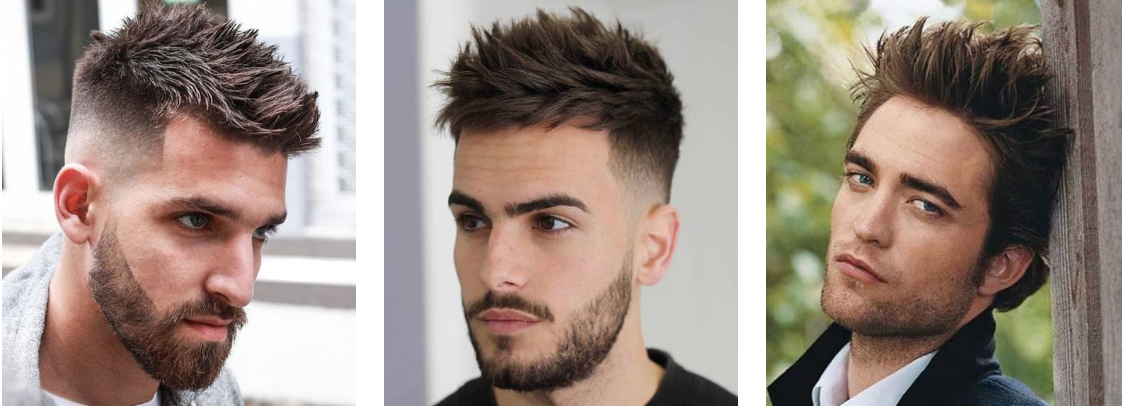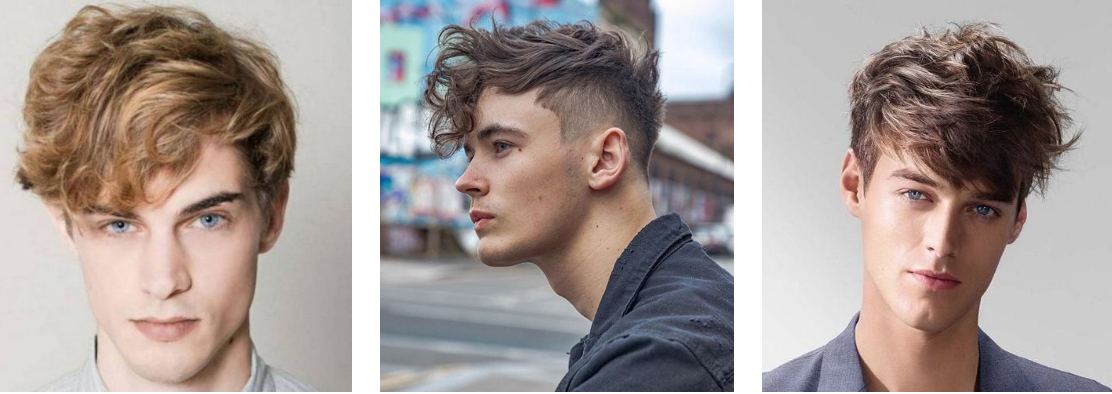|
Newly developed non-allergenic hair dyes offer effective hair coloring without the safety risks of traditional permanent hair dyes. A bad dye job is bad enough on its own, but an itchy and irritating allergic reaction to it is even worse. And people who become allergic to hair dye can develop reactions to many other common substances, transforming a simple cosmetic treatment into a big problem. Now, researchers reporting in ACS Sustainable Chemistry & Engineering have developed a range of permanent hair dyes that avoid the allergenic properties of traditional formulations. When applied as hair color, paraphenylenediamine (PPD) — a common ingredient in permanent dyes — undergoes a chemical reaction that turns the hair a dark color that won’t wash out over time. This reaction, however, can also produce compounds that bind proteins in the user’s skin, causing allergic responses, such as eczema and facial swelling. PPD can also sensitize users to other substances, including a compound commonly found in sunscreens and cosmetics, as well as common pigment and ink compounds. Alternatives have been proposed, but they generally are not water-soluble, and the safety of some of the compounds are not well understood. Gopalakrishnan Venkatesan and colleagues wanted to create new alternatives that would avoid the problems of PPD while still providing permanent hair coloring. The team prepared seven dyes based on PPD with modifications to the aromatic amine core. The modifications were chosen to potentially make the compounds less reactive toward proteins and less able to be absorbed into skin. All seven compounds permanently colored hair samples, producing a range of hues from rosy pinks to deep blacks that did not fade, even after three weeks of daily washing. The team then examined the dyes in a test commonly used in the cosmetics industry to determine if a product is a skin sensitizer. Five of the modified dyes were “weak” sensitizers, whereas PPD was “moderate.” Another test showed that the new compounds generated a reduced inflammatory response in cells compared to PPD. These results suggest that the new dyes can effectively color hair while also avoiding the potential allergenic and sensitization risks of more traditional ones. The authors acknowledge funding from the National University of Singapore. from EurekAlert! and ScienceDaily
0 Comments
This section is for the "Follically Challenged". There are so many conversations and articles on the topic and I want make sure you are getting good information. This month's article is from "With the Zeus, doctors will no longer turn away patients on account of their skin, hair type, or race as all humans can now benefit from this new FUE device," Umar said. All-Purpose Hair Transplant Graft Harvester Study Shows Potential Capabilities FUE is a type of hair transplant that requires physicians to change tools to accommodate different hair and scalp types. Now, a recent study highlights a single device aiming to treat all types of hair situations. The Dr.UGraft Zeus device is a tool used in Follicular Unit Extraction (FUE), a treatment for hair loss. It was created by Sanusi Umar, MD, a dermatologist in Manhattan Beach, California, to help address patients who may have been turn away because of their hair texture or hair loss severity. For an article published in the Clinical Cosmetic and Investigational Dermatology Journal, Umar and colleagues detail the device and its capabilities of extracting hair follicles in all types of FUE situations. The device uses a single punch design to perform FUE on body hair, textured hair—including kinky or curly hair, and long hair, according to the release. This expands the donor pool and hair supply for hair transplantation. “When I got into the hair transplant field, FUE in Afro-textured hair (such as my own) was considered the most challenging FUE scenario,” Umar said.“Dreaded by FUE practitioners, all existing tools typically fail to deliver results in this demographic consistently. So, I set out looking for a solution to this most difficult FUE challenge. It led to a different way of looking at FUE altogether." The article describes several patented and patent-pending inventions that led to the development of an "Intelligent Punch," and its driver called the Zeus, the press release explained. This journey led to the discovery of the importance of skin thickness and firmness as a primary cause of inconsistent performance by prior FUE tools. The device auto navigates changing skin textures and curly course texture of hair follicles deeply into their subsurface paths. "With the Zeus, doctors will no longer turn away patients on account of their skin, hair type, or race as all humans can now benefit from this new FUE device," Umar said. Reference: 1. An all-purpose hair transplant harvesting device - a first. Cision PR Newswire. Press Release. Published December 29, 2021. Accessed January 3, 2022. https://www.prnewswire.com/news-releases/an-all-purpose-hair-transplant-harvesting-device---a-first-301451389.html Did you know that your shampoo can contain ingredients harmful to both you and the environment? Chief among them: Sulfates. But what exactly are sulfates, and what other problematic shampoo ingredients should you avoid? Instead of harmful shampoo brands to avoid, we’ve made a list of 15 common and not-so-nice shampoo ingredients to watch out for — and why. What are the main ingredients of shampoo to skip? Read on to find out. 1. Ammonium Lauryl Sulfate or Sodium Laureth Sulfate (SLES) What are sulfates? Sulfates are very strong detergents that work through a chemical reaction, in which they bind with the sebum on our scalp and with water. When you rinse out the shampoo, sulfates take all the oils and residue with them. But while cleansing, they can also damage the hair, make it brittle, and increase frizz. 2. Sodium Lauryl Sulfate (SLS) This sulfate creates a lathering foam some people love, but it can compromise follicles when left on the scalp and it has other toxic effects on the human body. Yikes! Anyone with color-treated hair or dry hair should definitely avoid SLS, as it can fade your color and strip your strands of natural oils. 3. Parabens Parabens are also known to be harmful. They are used as a preservative to prevent bacteria from growing in cosmetics and shampoos. Parabens can mimic the hormone estrogen and have been linked to increased growth of breast cancer cells. 4. Sodium Chloride Sodium chloride is another name for salt. Sodium chloride in shampoo and conditioner is mainly there to make the consistency thicker. Salt can make an already-sensitive scalp dry and itchy, which can eventually cause hair loss. 5. Polyethylene Glycols (PEG) PEG is a thickening agent derived from petroleum that is often contaminated with byproducts. There has not been sufficient research done to conclude that PEGs themselves are as toxic as shampoo ingredients, but common byproducts in PEGs can be harmful. 6+7. Diethanolamine (DEA) and Triethanolamine (TEA) DEA and TEA are also emulsifiers and foam agents that reduce surface tension so water-soluble and oil-soluble ingredients can blend together. In 1998, researchers found a link between the topical application of DEA and cancer in animals, but the effects on humans are unclear. The European Commission has banned DEA in cosmetics. 8. Formaldehyde Formaldehyde is a known human carcinogen and has been proven to be absorbed through the skin in animal testing. Manufacturers often add it to products directly as a preservative, but it can also be released over time through a chemical process from other types of preservatives. If you’re wondering what to look for, a common one in shampoos is quaternium-15. They can also be found in chemicals used for Brazilian blowouts at hair salons. 9. Alcohol Most alcohols have a drying effect, and the higher up in the ingredients list they appear, the more alcohols the product contains. Some alcohols that are not as bad for dry hair begin with a “C” or an “S,” like Cetearyl alcohol and Stearyl alcohol. They can actually help your hair retain moisture. The ones that are bad if you already have dry hair usually have a “prop” in their name, like Isopropyl alcohol or propanol. 10. Synthetic Fragrances Products that have “fragrance” on their label can contain thousands of hidden chemicals. Some ingredients in fragranced cosmetic products can disrupt the reproductive system and cause cancer or asthma. They can also irritate the skin and scalp, which can lead to hair loss. 11. Synthetic Colors Most shampoos and conditioners are dyed with a synthetic color to make them look nice. These colors come from petroleum or coal-tar sources, all of which come with harmful health effects. Synthetic colors will normally go by FD&C or D&C combined with a number. 12. Dimethicone Dimethicone is a type of silicone that is used in a ton of hair products and contributes to product buildup that makes your hair feel greasy. Since it acts as a protecting cover on the surface of the hair, it stops moisture and nutrients from coming in and instead collects dirt and residue. It can clog the pores on the scalp and cause skin irritation. 13. Cocamidopropyl Betaine Cocamidopropyl betaine is another foam booster. Although it’s derived from coconut oil, it can have negative effects. This surfactant is used in hair products along with dimethylaminopropylamine, which can cause skin irritation, allergies, rosacea, and eczema. 14. Triclosan Triclosan was banned from being used in antibacterial soaps in 2016 but is still allowed in toothpaste, shampoos, and deodorants. It’s a chemical antibacterial agent known to cause hormone disruptions, which can lead to cancer and affect fetal development, among other things. 15. Retinyl Palmitate Retinyl palmitate is the ester of retinol combined with palmitic acid. It’s a known skin irritant that can cause peeling, scaling, redness, and itching. Side effects of retinyl palmitate may include cancer, reproductive problems, and organ toxicity. Harmless Shampoo Ingredients While there are many bad ingredients in shampoos and harmful shampoo brands, plenty of shampoos use only natural, non-toxic, and organic ingredients, and you can even make your own homemade hair treatments using ingredients from your kitchen. If you are suffering from hair loss or unhealthy hair growth and think chemicals such as the ones mentioned above may be to blame, try switching to a natural alternative. You can also try taking natural supplements that contain plant-derived ingredients that work synergistically to help your natural hair growth. from Nutrafol
There’s something extremely sexy on men with messy hairstyles. Effortless cool looks that are intentionally disheveled let confident men showcase their natural characteristics. In the ’90s, men favored messy hairstyles that required minimum effort to maintain. It was the age of grunge, brit-pop and low-rise jeans and none of them matched lined partings and classic, neat haircuts. However, styling rebellious messy hair may sometimes be tricky. Even the most meticulously sloppy haircut styles need to stand up properly and ideally with the least possible effort. A casually messy hairstyle is the perfect option, whether you’re heading out for drinks after work or for a romantic date. Whichever your hair type is curly, straight, wavy, thick, or thin hair, be sure to find a laidback style here. Here are the best messy hairstyles for men to get inspiration. Messy Crop Top If you’re looking for a timeless, simple yet refined hairstyle, opt for a messy French crop top. All you need is to leave the hair on top long to medium in length and then try a crop top fade. To create a rugged, sexy look, give it a tousle with a few styling products, such as a shine pomade, wax, or clay. Starting at the roots, apply a small amount of pomade through your locks, messing them up as you go. Slicked Back A messy swept-back hairstyle can be a fresh take on a retro style. It’s a sleek look that adds a grunge vibe to your whole appearance. Comb all your hair back and create a small pomp or quiff for an everyday look. Or, if you prefer an edgy, slick back messy style, opt for an undercut or undercut fade on the sides. In terms of styling, use a matte hair product like clay, cream, or lightweight wax to add some height, movement and flow. Short Spiky Messy spiky hair has become very popular over the last few years. They add a fun, sexy, effortless cool vibe to those who want to make a bold appearance. Short spiky hair is a great choice to save time when you don’t have much time for styling. If you want to cover any bald spots or have thin hair, this is the hairstyle you should go for. You can ask for a messy and textured on-top hairstyle with a taper fade or undercut on the sides. When styling a messy spiky hairstyle, apply a strong pomade or a matte wax to reassure that your hair will stay in place all day. Textured Fringe Modern and trendy, a fringe haircut can be the perfect choice for guys with curly, wavy, or medium-length hair. With a textured fringe on top, you can enhance your facial features and look extremely hot. Leave your hair in the front to grow about 2 to 3 inches in length. Then experiment with a fade on the sides and with an angular, messy, or textured fringe on top. A matte or low-shine pomade will help you get the texture and give a naturally messy look. How To Style Messy Hair Once you decide on the messy hairstyle that best flatters your face shape and features, it’s important to keep it that way. It’s better to start styling after shampooing your hair and then gently towel drying your hair. Take a small amount of good-quality clay or wax and rub it between your hands to warm it. Apply the product evenly through your hair and run your fingers to mess it up. Ultimately, you’ll need to tousle and move your hair to one side until you get the desired messy look. from OnPointFresh
2/15/2022 Mask Mandate LiftedUpdate from Hair by Brian Mask Mandate Lifted I'm sure you are very much aware that California and San Francisco County will be lifting universal mask requirements for most indoor public settings beginning Wednesday, February 16, for vaccinated individuals.
The state continues to require that people who haven't gotten their vaccinations wear masks in certain indoor public settings (see the guidance linked below for the notable exceptions). This means that if you are not vaccinated and you come in to the salon, the state says you must wear a face covering. This also means that I may ask you for proof of vaccination to determine whether you should wear a mask. While all of us stylists working in the salon are vaccinated some may choose to still wear a face covering. You also have this choice. From the beginning, I have been committed to creating a space that not only is safe, but also feels safe for all of us. I am looking forward to seeing your smiling face. - Brian ✂️ Guidance for the Use of Face Masks https://www.cdph.ca.gov/Programs/CID/DCDC/Pages/COVID-19/guidance-for-face-coverings.aspx |
Hair by BrianMy name is Brian and I help people confidently take on the world. CategoriesAll Advice Announcement Awards Balayage Barbering Beach Waves Beauty News Book Now Brazilian Treatment Clients Cool Facts COVID 19 Health COVID 19 Update Curlies EGift Card Films Follically Challenged Gossip Grooming Hair Care Haircolor Haircut Hair Facts Hair History Hair Loss Hair Styling Hair Tips Hair Tools Health Health And Safety Healthy Hair Highlights Holidays Humor Mens Hair Men's Long Hair Newsletter Ombre Policies Procedures Press Release Previous Blog Privacy Policy Product Knowledge Product Reviews Promotions Read Your Labels Recommendations Reviews Scalp Health Science Services Smoothing Treatments Social Media Summer Hair Tips Textured Hair Thinning Hair Travel Tips Trending Wellness Womens Hair Archives
April 2025
|
|
Hey...
Your Mom Called! Book today! |
Sunday: 11am-5pm
Monday: 11am-6pm Tuesday: 10am - 6pm Wednesday: 10am - 6pm Thursday: By Appointment Friday: By Appointment Saturday: By Appointment |












 RSS Feed
RSS Feed